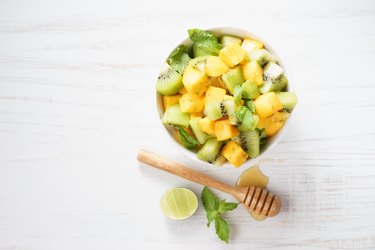
There's no doubt that fruits are a healthy addition to your diet. Not only do they contain lots of vitamins and minerals, but they're typically unprocessed and are great natural sources of fiber. In fact, Health.gov says you need 2 to 2 1/2 cups of fruit daily if you follow a 2,000-calorie diet. That's why it might come as a surprise that some fruits can cause gas and bloating.
Although fruit-fueled gas may be embarrassing, the National Institutes of Health suggests that it's rare for anyone to have too much gas. Gas and bloating caused by fruits or other types of food are more a source of annoyance than anything else. And once you understand which fruits are the main culprits, you can tweak how you eat them to minimize discomfort and embarrassment.
Video of the Day
Video of the Day
Read more: Foods That Reduce Gas and Bloating
Fruits That May Cause Gas
Apples may cause gas because they contain fructose. Fructose makes fruit taste sweet, but it can also cause bloating and gas as it's a type of sugar that some people find hard to digest. Not everyone has trouble digesting fructose, but if you're one of those who does and you've just polished off an apple, you may find yourself feeling bloated and seeking the nearest bathroom. Women's Health suggests eating half an apple at a time and chewing it slowly, which may help break the fructose down before it wreaks havoc on your digestive system.
Pears, another fruit beloved by many, contain lots of fiber in addition to pectin, which helps lower cholesterol and makes you feel full. But it's the sorbitol, a sugar alcohol found in pears, that can cause bloating. Sorbitol is absorbed slowly by the body, and when it finds its way to your colon, it ferments. This is what causes bloating, gas and even cramps in some people, although exercise may help to move the gas through your body faster.
Cherries, grapes, mangoes and pineapple are also some of the usual suspects behind bloating and gas. You may love these fruits because they're sweet, but if your small intestine doesn't absorb all the sugar, your large intestine may, which results in bloating and gas. As with apples, take your time when eating these fruits and limit your serving size to half a cup.
Dried fruits are portable, as sweet as candy and don't need to be refrigerated, which is all good. But some dried fruits, such as raisins and prunes, can cause gas and bloating. The concentrated sugar and fiber in these foods help to feed your colon, which then does you the favor of fermenting any undigested sugar and fiber.
Read more: Vegetables & Fruits That Cause Gas
Less-Gassy Fruits
Berries, including blueberries, blackberries, kiwifruit and strawberries, and citrus fruits, such as grapefruits, mandarins and oranges, are all less likely to give you gas or bloating grief, and the same goes for bananas, grapes and cantaloupe.
Read more: Fruits That Won't Make You Bloated
How to Eat Foods That Cause Gas
In addition to chewing gas-producing fruits and other gassy foods thoroughly, one way to consume them without the side effects is to cook them. You'll lose some of the nutritional value, but you'll be less likely to suffer with bloating and gas afterward.
When eating dried fruits, drink lots of water to temper their gas-producing sugars and fiber, and take a walk or engage in some other physical activity to help get rid of gas.
Gas and bloating originate in your colon because of the many billions of bacteria that live there. They consume the indigestible fiber that you eat, helping your body to stay healthy. But some bacteria particularly love certain foods and may generate gas via their production of hydrogen and methane, which is harmless although it may be aggravating.
The Oregon Clinic suggests that you consume your favorite gas-causing fruits in smaller quantities and gradually increase the amount of fiber in your diet over a few weeks' time.
- National Digestive Diseases Information Clearinghouse: Gas in the Digestive Tract
- MedlinePlus: Fiber
- Women's Health: Nine Fruits That Cause Belly Bloat
- Oregon Clinic: Diet for Preventing Gas and Flatulence
- Medical News Today: Which Foods Make You Bloated?
- Health.gov: Health Facts: Eat Plenty of Fruits and Vegetables